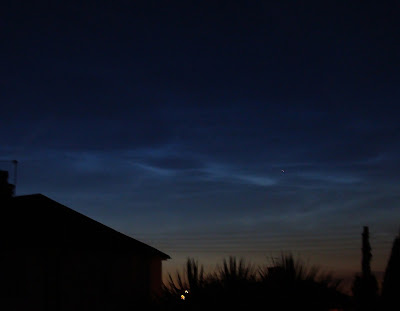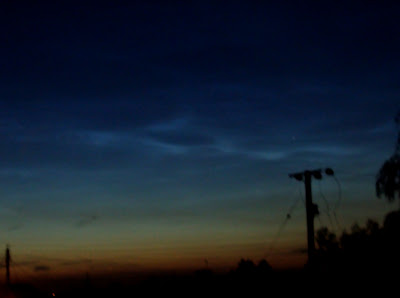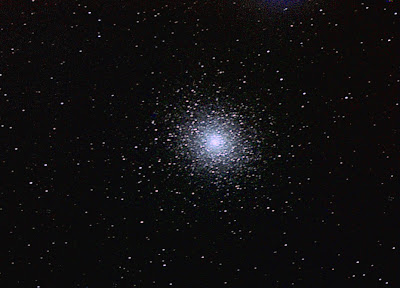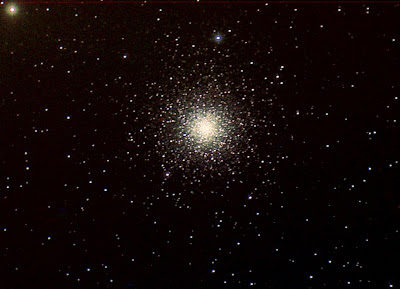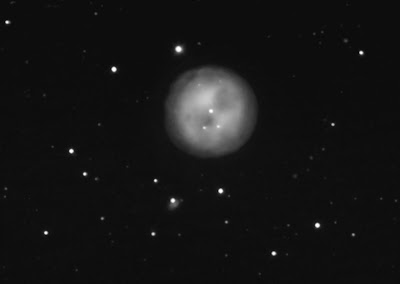
Click on image to enlarge.
Object: Messier 38 (NGC 1912) & NGC 1907
Type: Open Cluster(s)
Distance: 4,200 light years (NGC 1907, 4.500 light years)
Distance: 4,200 light years (NGC 1907, 4.500 light years)
Constellation: Auriga
Date: 07 March 2010
Equipment: SXV-H9, Vixen ED 114mm aperture f5.3 refractor, ATIK manual filter wheel, Astronomix LRGB filters
Subframes: 20 x 60 seconds luminance (unbinned), 20 X 40 seconds each for red, green and blue channels (2x2 binned), 16 flats/flat darks in luminance only, calibrated and stacked in AIP4Win, tweaked in AstroArt and PSP7.
A lot of images I've seen of open clusters tend to be a bit overstretched, with faint background stars being amplified to the extent that the cluster is lost against them. It's all a question of personal preference of course, but with open clusters I think it's important to try to aim for something that still resembles a view through an eyepiece.
This image, modest though it is, nicely captures Burnham's "inverted Pi" (or Webb's "oblique cross") of bright stars at the heart of M38. The eye can't really register star colours, but mild processing brought out a pleasing mixture of blue and pink stars across the field. Purists may object to the blue flaring around some of the stars (colour correction on my old Vixen, good as it is, still isn't as good as modern APOs) but I quite like the effect.
Open clusters tend to be overlooked for the splashier or more exotic objects in the sky when it comes to imaging. I like them because they offer easy targets that give very satisfying results without long exposures or too much processing.
This was my first imaging run for quite a while, and with a new EQ6 Pro mount. I've been enjoying views at the eyepiece since I've had the new toy, and whilst I've been getting used to it. I nearly didn't bother, as the line up of M35-M38 from Gemini to Auriga grabbed my eye for a couple of hours or so.
In the end, M38 was the only one in that famous line that I had never imaged - I was also struck visually by how obvious little NGC1907 was (although supposedly a couple of magnitudes fainter than its bigger brother, it makes up for that in compactness). So I blew the dust off of (the outside!) of the SXV-H9, and was pleased to find that both clusters fitted quite nicely on the chip.
I had had a lot of trouble with my old GPDX Skysensor combination of late, and decided back in summer last year to give it a ten-year service. The motor had been stalling in RA (which I attributed to a stiff bearing) and the backlash in RA and Dec was getting unmanageable. The mount came apart easily enough and I cleaned out the tar-like brown gunk from the bearing faces and drive gear that Vixen calls lubricant, and regreased it all with some lithium grease. The worm assemblies I cleaned up with a toothbrush and re-lubricated with some greenish specialist worm gear grease one of the instrument guys at work gave me.
It all went back together just fine and the sticky bearing problem seemed to have been beaten. However, no matter how much I tried adjusting the worm tensioners and bearing end plays, I couldn't reduce the rather large backlash in both axes without the worms becoming too stiff for the motors to turn easily. Added to that, every so often, the RA drive would just fly off randomly at top speed, requiring everything to be turned off to stop it.
This seemed to be attributable to the cheapo nastio plastic connector that plugs the motor cables into the Skysensor handset. I made up an aluminium backplate for the handset, and clamped the cable to it, and this seemed to fix the problem.
But the backlash was defeating my attempts at autoguiding, and I didn't really trust the drives any more - I was worried that the motors would speed off when I was wasn't watching them, smashing the scope into the mount and burning themselves out.
I'd seen both the EQ5 and EQ6 in action, and they seemed to offer good quality and "autoguider friendly" mounts at a reasonable price. I'd also noticed that Orion Optics had quietly dropped the new Vixen mounts (and that stupid Skybook) for their scopes, in favour of the EQ6, which to me spoke volumes.
So I bit the bullet and treated myself to an EQ6. I liked the idea of the extra load capacity offered by the EQ6, as my refractor, guide/spotting scope and imaging equipment all weighs in at around 10 kg total, which is pushing it on the GPDX and probably would for the EQ5 as well.
The EQ6 is a hefty beast, and so I also invested in a trolley with pneumatic tyres to put the whole set-up on. I'd been struggling with the weight of my existing set-up anyway, which was mounted on a hefty wooden box that supported the mount stand and held the electricals. The platform it all used to stand on had also gone rotten, which accounted for my problems in maintaining polar alignment.
I relaid that, and pounded some three foot galvanised scaffold poles into the ground for the screw-down legs of the trolley to stand on.
Set-up is now a breeze and much easier on my aging back, despite the significant increase in weight.
The handset menu and alignment routines aren't as good as the Skysensor (why won't it remember the damn date and time, for example?), but then nothing would be. Vixen were insane to stop making it - it was let down only by its poor electrical connectors.
To date, I've only used the EQ6 for imaging this once, having been quite happy to get used to the mount for visual observation at the moment. The EQ6 is remarkably quiet compared to the old GPDX drives, and the handset direction prompts appears to be completely without backlash, which augers well for when I get around to trying out autoguiding.
GoTo accuracy seems reasonable, although I've found three star alignment to be a bit hit and miss. Provided you stick with the stars the SynScan controller volunteers, things go smoothly. The Skysensor let you keep choosing stars until you could get a three star alignment to stick. As my horizons are restricted, this was quite useful. The EQ6 SynScan just rejects your three star alignment if something isn't quite right, and you have to start again.
For imaging though, my own tests suggests that one star alignment will probably be good enough, provided the reference star is close to the target.
One oddity that I came across was that the drives seemed to freeze if I tried to use a star from the SAO menu as a aid to improving pointing accuracy. Downloading the latest software update from the Synscan web-site seemed to fix that bug, however.
Periodic error of the EQ6 isn't in the same league as the GPDX, as expected. My old mount is around 3 arc seconds, the EQ6 is around 20-25 by my estimates! Autoguiding or (at the very least) PEC is going to be needed for any exposures over a minute, or any focal lengths longer than the 600mm of my refractor.
Still, my first imaging effort was encouraging, and I'll have to see how things progress, work and family commitments permitting!
Equipment: SXV-H9, Vixen ED 114mm aperture f5.3 refractor, ATIK manual filter wheel, Astronomix LRGB filters
Subframes: 20 x 60 seconds luminance (unbinned), 20 X 40 seconds each for red, green and blue channels (2x2 binned), 16 flats/flat darks in luminance only, calibrated and stacked in AIP4Win, tweaked in AstroArt and PSP7.
A lot of images I've seen of open clusters tend to be a bit overstretched, with faint background stars being amplified to the extent that the cluster is lost against them. It's all a question of personal preference of course, but with open clusters I think it's important to try to aim for something that still resembles a view through an eyepiece.
This image, modest though it is, nicely captures Burnham's "inverted Pi" (or Webb's "oblique cross") of bright stars at the heart of M38. The eye can't really register star colours, but mild processing brought out a pleasing mixture of blue and pink stars across the field. Purists may object to the blue flaring around some of the stars (colour correction on my old Vixen, good as it is, still isn't as good as modern APOs) but I quite like the effect.
Open clusters tend to be overlooked for the splashier or more exotic objects in the sky when it comes to imaging. I like them because they offer easy targets that give very satisfying results without long exposures or too much processing.
This was my first imaging run for quite a while, and with a new EQ6 Pro mount. I've been enjoying views at the eyepiece since I've had the new toy, and whilst I've been getting used to it. I nearly didn't bother, as the line up of M35-M38 from Gemini to Auriga grabbed my eye for a couple of hours or so.
In the end, M38 was the only one in that famous line that I had never imaged - I was also struck visually by how obvious little NGC1907 was (although supposedly a couple of magnitudes fainter than its bigger brother, it makes up for that in compactness). So I blew the dust off of (the outside!) of the SXV-H9, and was pleased to find that both clusters fitted quite nicely on the chip.
I had had a lot of trouble with my old GPDX Skysensor combination of late, and decided back in summer last year to give it a ten-year service. The motor had been stalling in RA (which I attributed to a stiff bearing) and the backlash in RA and Dec was getting unmanageable. The mount came apart easily enough and I cleaned out the tar-like brown gunk from the bearing faces and drive gear that Vixen calls lubricant, and regreased it all with some lithium grease. The worm assemblies I cleaned up with a toothbrush and re-lubricated with some greenish specialist worm gear grease one of the instrument guys at work gave me.
It all went back together just fine and the sticky bearing problem seemed to have been beaten. However, no matter how much I tried adjusting the worm tensioners and bearing end plays, I couldn't reduce the rather large backlash in both axes without the worms becoming too stiff for the motors to turn easily. Added to that, every so often, the RA drive would just fly off randomly at top speed, requiring everything to be turned off to stop it.
This seemed to be attributable to the cheapo nastio plastic connector that plugs the motor cables into the Skysensor handset. I made up an aluminium backplate for the handset, and clamped the cable to it, and this seemed to fix the problem.
But the backlash was defeating my attempts at autoguiding, and I didn't really trust the drives any more - I was worried that the motors would speed off when I was wasn't watching them, smashing the scope into the mount and burning themselves out.
I'd seen both the EQ5 and EQ6 in action, and they seemed to offer good quality and "autoguider friendly" mounts at a reasonable price. I'd also noticed that Orion Optics had quietly dropped the new Vixen mounts (and that stupid Skybook) for their scopes, in favour of the EQ6, which to me spoke volumes.
So I bit the bullet and treated myself to an EQ6. I liked the idea of the extra load capacity offered by the EQ6, as my refractor, guide/spotting scope and imaging equipment all weighs in at around 10 kg total, which is pushing it on the GPDX and probably would for the EQ5 as well.
The EQ6 is a hefty beast, and so I also invested in a trolley with pneumatic tyres to put the whole set-up on. I'd been struggling with the weight of my existing set-up anyway, which was mounted on a hefty wooden box that supported the mount stand and held the electricals. The platform it all used to stand on had also gone rotten, which accounted for my problems in maintaining polar alignment.
I relaid that, and pounded some three foot galvanised scaffold poles into the ground for the screw-down legs of the trolley to stand on.
Set-up is now a breeze and much easier on my aging back, despite the significant increase in weight.
The handset menu and alignment routines aren't as good as the Skysensor (why won't it remember the damn date and time, for example?), but then nothing would be. Vixen were insane to stop making it - it was let down only by its poor electrical connectors.
To date, I've only used the EQ6 for imaging this once, having been quite happy to get used to the mount for visual observation at the moment. The EQ6 is remarkably quiet compared to the old GPDX drives, and the handset direction prompts appears to be completely without backlash, which augers well for when I get around to trying out autoguiding.
GoTo accuracy seems reasonable, although I've found three star alignment to be a bit hit and miss. Provided you stick with the stars the SynScan controller volunteers, things go smoothly. The Skysensor let you keep choosing stars until you could get a three star alignment to stick. As my horizons are restricted, this was quite useful. The EQ6 SynScan just rejects your three star alignment if something isn't quite right, and you have to start again.
For imaging though, my own tests suggests that one star alignment will probably be good enough, provided the reference star is close to the target.
One oddity that I came across was that the drives seemed to freeze if I tried to use a star from the SAO menu as a aid to improving pointing accuracy. Downloading the latest software update from the Synscan web-site seemed to fix that bug, however.
Periodic error of the EQ6 isn't in the same league as the GPDX, as expected. My old mount is around 3 arc seconds, the EQ6 is around 20-25 by my estimates! Autoguiding or (at the very least) PEC is going to be needed for any exposures over a minute, or any focal lengths longer than the 600mm of my refractor.
Still, my first imaging effort was encouraging, and I'll have to see how things progress, work and family commitments permitting!


